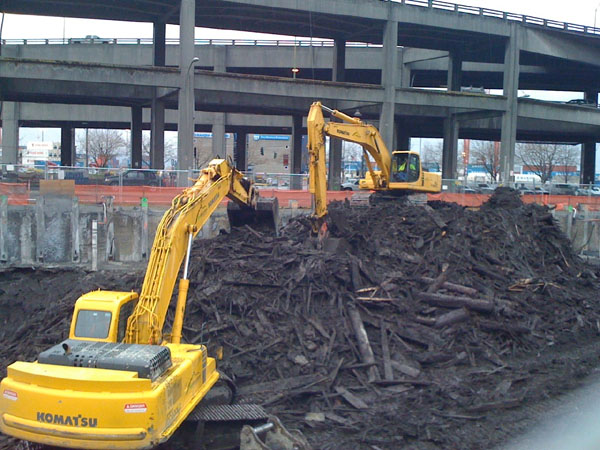From Skid Row to Starbucks
The alleged etymological origins of the term "skid row" are in the Pacific Northwest, in districts where lumbermen "skidded" logs down towards mills and ships lining the waterfront, and where disreputable trades served lumbermen who were eager to spend their earnings on vices after long and sober months in the woods.
Instead of digging down into post-glacial gravel, backhoes found a morass of rotting timber instead: the discarded slash from the old mills, the century-old pilings of old wharves and railroads, and the miscellaneous debris that nineteenth-century land developers had tossed into the city's marshy waterfront to transform wetlands into dry quays above sea level.
This item came to my attention via hugeasscity, which noted that the city's plan to renovate the aging Alaskan Way Viaduct (the concrete urban renewal scar visible in the background of the photo above) calls for putting the freeway underground. Which sounds like a neat-o plan for a Tomorrowland version of Seattle, until you consider that the whole gleaming, modern Seattle waterfront district is actually built atop an unstable, sinking pile of wood. Plus an active fault line.
In the end, it doesn't matter how many lattes and condos you sell above ground: the roots of the city will always be in Skid Row.
One of the most famous skid rows is in the neighborhood around Seattle's Pioneer Square, centered around Henry Yesler's sawmill. The neighborhood followed a familiar skid row trajectory: first, the waterfront industry moved away. Then, urban renewal projects manifested the city's disrespect for the neighborhood by demolishing lots of buildings and leaving the rest to wither in the shadows of ugly, soot-soaked freeway viaducts. Under the traffic, intentionally hidden from view, strip clubs, drug vendors, and homeless agencies flourished.
And then, when developers realized how close these skid rows were to downtown, and how cheap the real estate still was, the skid rows quickly flipped into yuppie pleasure districts, from New York's Bowery to San Francisco's Tenderloin District. And Pioneer Square attained the ideal embodiment of this post-industrial destiny when Starbucks built its complex of corporate headquarters offices in the neighborhood.
By the time crews started excavating for the 4-level underground parking garage, they confirmed that the old age of logging was dead and buried. Literally.
Instead of digging down into post-glacial gravel, backhoes found a morass of rotting timber instead: the discarded slash from the old mills, the century-old pilings of old wharves and railroads, and the miscellaneous debris that nineteenth-century land developers had tossed into the city's marshy waterfront to transform wetlands into dry quays above sea level.
This item came to my attention via hugeasscity, which noted that the city's plan to renovate the aging Alaskan Way Viaduct (the concrete urban renewal scar visible in the background of the photo above) calls for putting the freeway underground. Which sounds like a neat-o plan for a Tomorrowland version of Seattle, until you consider that the whole gleaming, modern Seattle waterfront district is actually built atop an unstable, sinking pile of wood. Plus an active fault line.
In the end, it doesn't matter how many lattes and condos you sell above ground: the roots of the city will always be in Skid Row.
PS- the bike tour to Walden post I'd promised yesterday is still coming - check back tomorrow! I'm going on a blogging tear this week to make up for lost time.





2 comments:
Wow. Great post. I too think its horrible when cities give the residents what they want, like profitable upscale businesses. Instead, lets keep cities industrial and polluted, overcrowded, and the kinds of places people feel they are escaping from when they move to the suburbs or the countryside.
The movement back to cities has largely come out of the idea that they are places of collaboration and excitement, which stems from people having more of what they want and less of what they don't. The reason for renewal and gentrification is because there is demand for it, not because it is being pushed on a populace that doesn't want it.
Har har. No, I don't think that a city's or a neighborhood's renewal or reinvention is a bad thing; I find it's usually pretty interesting (which is why I wrote this post in the first place).
And sure, I'd agree that a Starbucks office building is nicer to be around than a homeless shelter (then again, I'm not homeless).
But it's worth remembering that just because Starbucks is there now doesn't mean that Seattle doesn't need lumber or have any homeless people anymore. The sawmills and homeless shelters have just moved somewhere else.
Don't you think that Seattle would be a bit more exciting, more authentic, and more attractive to creative workers if it reminded those Starbucks workers about their neighborhood's connection to the famous forests of the Pacific Northwest? Or even if those workers encountered some strip clubs and homeless people on their way to work?
I guess I don't really believe that cities can really revitalize themselves by imitating the sterility and blandness of suburban office parks.
Post a Comment